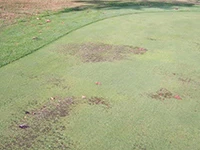
Zac Reicher, Ph.D., is a part of the Bayer Green Solutions Team.
Identifying the Problem
Anthracnose can affect most turfgrass species, but annual bluegrass and creeping bentgrass greens tend to be most susceptible. Interestingly, the disease usually only attacks annual bluegrass or creeping bentgrass on a particular green or golf course, but rarely both species. Anthracnose can occur as a foliar blight or a basal rot – which affects crowns, roots and stolons. Anthracnose foliar blight is most common during high temperatures and the stress of summer, causing yellowing or browning of the older leaves first and eventual loss of density. The characteristic acervuli – or fruiting body of the fungus – can often be seen on infected plants, especially on the leaves of dead and dying plants. That said, they may not be a conclusive diagnostic tool unless found on leaves of healthy green plants.
Conversely, anthracnose basal rot is often found on annual bluegrass in the spring or fall during periods of cold, wet weather, but can also be found under summer wilt stress. Basal rot anthracnose can develop from foliar blighting or independently. Symptoms first appear as orange to yellow speckled spots up to 0.5 inches in diameter. These patches turn yellow as the disease progresses. And, eventually, individual plants will die. Carefully pulling back the leaves on infected plants will reveal a water-soaked or black-colored stem base.
In warmer weather, basal rot-infected plants will turn reddish brown or yellow and will thin out in patches 3 feet or more in diameter. Anthracnose forms no characteristic leaf lesions or mycelium, unlike many other foliar diseases. Thus, symptoms can be confused with other diseases, especially the basal rot form. It is important to have microscopic confirmation by a qualified turf disease diagnostic lab.
Key cultural strategies
Because anthracnose occurs when turf growth is slow during high or low temperatures, recovery is usually difficult and slow. Therefore, preventive cultural practices and fungicide controls are typically most effective, especially where there is a history of the disease.
Nearly any practice that reduces turfgrass stress and helps maintain moderate growth should help minimize anthracnose. Mowing at greater than 0.125 inches will help reduce anthracnose, and rolling or double mowing can be used safely to maintain the necessary green speeds. Typical spoon-feeding of 0.1 to 0.2 lbs N/1000 sq. ft. every 7 to 14 days will also help minimize anthracnose. Light and frequent sand topdressing can prove helpful by burying the mycelium or acervuli. However, topdressing rates must be limited so that turf can be watered or brushed-in easily to limit stress.
Aerify regularly to limit compaction and plant stress. Avoid aggressive aerification while anthracnose is active. To help lessen anthracnose, irrigate at 60-80 percent base ET to prevent moisture stress to shallowly rooted turf. Finally, try applying Proxy in the spring to control annual bluegrass and conserve plant resources in order to increase summer stress tolerance and limit susceptibility to anthracnose.
Integrated fungicide solution tips
• Apply fungicides prior to the extended, cool, wet weather in the fall, winter and spring. This can help reduce the incidence of basal rot in the spring and fall.
• Use DMI fungicides for early season control of fairy ring, dollar spot, and summer patch to help limit anthracnose.
• Begin summer preventive programs targeted specifically for anthracnose when average soil temperatures at the 2-4-inch depth are 65-68 F, many weeks before onset of symptoms.
• Fungicide resistance can be problematic with anthracnose. QoI and benzimidazole fungicides may not provide adequate control due to resistance, but other fungicide classes remain effective for anthracnose control.
• Chipco Signature + Daconil Ultrex, Mirage Stressgard, and Tartan are excellent solutions for anthracnose control and also promote plant health to further limit susceptibility to anthracnose.
• Curative controls are not as effective as preventative applications. However, curative controls can include a DMI fungicide – such as Mirage or Tartan – plus a multi-site fungicide, like chlorothalonil, to help arrest the infection. Follow the treatment with a Chipco Signature program to promote plant health and recovery.
• Be sure to follow label instructions for all pesticides, particularly directions for resistance management when applying fungicides for anthracnose.
Latest from Golf Course Industry
- From the publisher’s pen: Conscientious of a bigger role
- Bernhard and Company partners with Laguna Golf Phuket
- Terre Blanche showcases environmental stewardship
- VIDEO: Introducing our December issue
- Bernhard and Company introduces Soil Scout
- Nu-Pipe donates to GCSAA Foundation’s Centennial Campaign
- GCSAA enhances golf course BMP tool
- Melrose leadership programs sending 18 to 2026 GCSAA Conference and Trade Show





